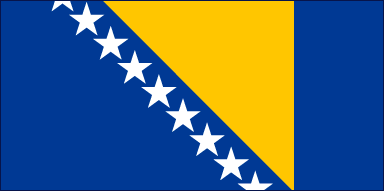
The Bosnian flag has a blue background with seven white five-pointed stars falling from the left to the right, crossing the flag in a diagonal and vertical pattern. There are two half stars above and below the stars. A yellow isosceles triangle may be seen to the right of the stars.
The triangle’s three points represent Bosnia’s three ethnic groups: Serbs, Bosniaks, and Croats. Yellow connotes liberality, whereas blue stands for honesty, commitment, justice, and integrity. Europe is represented by the white stars.
| Official Name: | Bosnia and Herzegovina |
| Proportion: | 1:2 |
| Adopted on: | February 4, 1998 |
| Location: | South-eastern Europe, on the Balkan Peninsula |
| Capital City: | Sarajevo |
| Major Cities: | Nevesinje, Visoko, Lukavac, Cazin |
| Area: | 19,741 square miles |
| Population: | 3,839,737 |
| Currency: | Convertible Mark (BAM) |
| Official Languages: | Bosnian, Croatian, Serbian |
| National Anthem: | Drzavna himna Bosne i Hercegovine |
| National symbol(s): | golden lily |
| National colors: | blue, yellow, white |
| National anthem: | |
| Name: | “Drzavna himna Bosne i Hercegovine” (The National Anthem of Bosnia and Herzegovina) |
| Lyrics/Music: | none officially; Dusan SESTIC and Benjamin ISOVIC/Dusan SESTIC |
Historical Background
The current design of the Bosnian flag was officially adopted on February 4, 1998, following the signing of the Dayton Agreement in 1995. The flag was created as a result of complex negotiations and aims to represent the shared history and aspirations of Bosnia and Herzegovina’s diverse population.
Design and Colors
The Bosnian flag features a blue field with a wide yellow vertical band at the hoist side. On the blue field, there are seven white five-pointed stars arranged in an arc, symbolizing a stylized version of the Pleiades constellation.
Symbolism of the Bosnian Flag
Each element of the Bosnian flag holds significant symbolism. The blue color represents peace and coexistence, reflecting the desire for harmony among the country’s diverse population. The yellow band symbolizes the bright future and prosperity of Bosnia and Herzegovina. The seven white stars represent the Pleiades constellation, also known as the Seven Sisters, which has cultural significance and symbolism in various civilizations and signifies the unity and harmony of the country’s three main ethnic groups.
Statehood Day of Bosnia and Herzegovina
Statehood Day of Bosnia and Herzegovina is celebrated on November 25th each year. This day commemorates the country’s independence and serves as an occasion to celebrate the Bosnian flag and the values it represents, such as unity, diversity, and peace.
FAQs
Q1: When was the current design of the Bosnian flag adopted?
The current design of the Bosnian flag was officially adopted on February 4, 1998.
Q2: What do the colors on the Bosnian flag represent?
The blue color represents peace and coexistence, while the yellow band symbolizes the bright future and prosperity of Bosnia and Herzegovina.
Q3: What do the seven stars on the Bosnian flag represent?
The seven white stars represent the Pleiades constellation, also known as the Seven Sisters, and symbolize the unity and harmony among Bosnia and Herzegovina’s three main ethnic groups.
Q4: What is Statehood Day in Bosnia and Herzegovina?
Statehood Day of Bosnia and Herzegovina is celebrated on November 25th each year, commemorating the country’s independence and celebrating the values of unity, diversity, and peace represented by the Bosnian flag.

